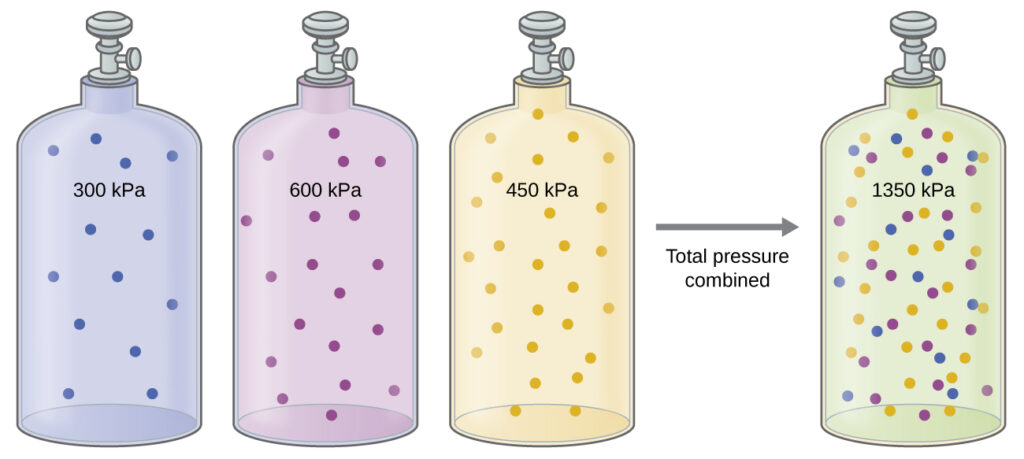Unless they chemically react with each other, the individual gases in a mixture of gases do not affect each other’s pressure. Each individual gas in a mixture exerts the same pressure that it would exert if it were present alone in the container ([link]). The pressure exerted by each individual gas in a mixture is called its partial pressure. This observation is summarized by Dalton’s law of partial pressures: The total pressure of a mixture of ideal gases is equal to the sum of the partial pressures of the component gases: $$P_{Total}=P_A+P_B+P_C+…=Σ_iP_i$$
In the equation PTotal is the total pressure of a mixture of gases, PA is the partial pressure of gas A; PB is the partial pressure of gas B; PC is the partial pressure of gas C; and so on.

The partial pressure of gas A is related to the total pressure of the gas mixture via its mole fraction (X), a unit of concentration defined as the number of moles of a component of a solution divided by the total number of moles of all components:
$$P_A=X_A×P_{Total}\qquad where\qquad X_A=\frac{n_A}{n_{Total}}$$
where PA, XA, and nA are the partial pressure, mole fraction, and number of moles of gas A, respectively, and nTotal is the number of moles of all components in the mixture.
The Pressure of a Mixture of Gases
A 10.0-L vessel contains 2.50 ×10−3 mol of H2, 1.00 ×10−3 mol of He, and 3.00 ×10−4 mol of Ne at 35 °C.
(a) What are the partial pressures of each of the gases?
(b) What is the total pressure in atmospheres?
Solution
The gases behave independently, so the partial pressure of each gas can be determined from the ideal gas equation, using $P=\frac{nRT}{V}$:
$$P_{H_2}=\frac{(2.50×10^{−3}\;\require{enclose}\enclose{horizontalstrike}{mol})(0.08206\; \enclose{horizontalstrike}{L}\;atm\; \enclose{horizontalstrike}{mol^{-1}K^{−1}})(308\; \enclose{horizontalstrike}{K})}{10.0\; \enclose{horizontalstrike} {L}}=6.32×10^{−3}\;atm$$
$$P_{He}= \frac{(1.00×10^{−3}\;\enclose{horizontalstrike}{mol})(0.08206\; \enclose{horizontalstrike}{L}\;atm\; \enclose{horizontalstrike}{mol^{-1}K^{−1}})(308\; \enclose{horizontalstrike}{K})}{10.0\; \enclose{horizontalstrike} {L}}=2.53×10^{−3}\;atm$$
$$P_{Ne}=\frac{(3.00×10^{−4}\;\enclose{horizontalstrike}{mol})(0.08206\; \enclose{horizontalstrike}{L}\;atm\; \enclose{horizontalstrike}{mol^{-1}K^{−1}})(308\; \enclose{horizontalstrike}{K})}{10.0\; \enclose{horizontalstrike} {L}}=7.58×10^{−4}\;atm$$
The total pressure is given by the sum of the partial pressures:
$$P_T=P_{H_2}+P_{He}+P_{Ne}=(0.00632+0.00253+0.00076)\;atm=9.61×10^{−3}\;atm$$
Check Your Learning
A 5.73-L flask at 25 °C contains 0.0388 mol of N2, 0.147 mol of CO, and 0.0803 mol of H2. What is the total pressure in the flask in atmospheres?
Answer:
1.137 atm
Here is another example of this concept, but dealing with mole fraction calculations.
The Pressure of a Mixture of Gases
A gas mixture used for anesthesia contains 2.83 mol oxygen, O2, and 8.41 mol nitrous oxide, N2O. The total pressure of the mixture is 192 kPa.
(a) What are the mole fractions of O2 and N2O?
(b) What are the partial pressures of O2 and N2O?
Solution
The mole fraction is given by $X_A=\frac{n_A}{n_{Total}}$ and the partial pressure is PA = XA ×PTotal.
For O2,
$$X_{O_2}=\frac{n_{O_2}}{n_{Total}}=\frac{2.83\;mol}{(2.83+8.41)\;mol}=0.252$$
and
$$P_{O_2}=X_{O_2}\times P_{Total}=0.252\times 192\;kPa=48.4\;kPa$$
For N2O,
$$X_{N_2O}=\frac{n_{N_2O}}{n_{Total}}=\frac{8.41\;mol}{(2.83+8.41)\;mol}=0.748$$
and
$$P_{N_2O}=X _{N_2O} \times P_{Total}=0.748\times 192\;kPa=143.6\;kPa$$
Check Your Learning
What is the pressure of a mixture of 0.200 g of H2, 1.00 g of N2, and 0.820 g of Ar in a container with a volume of 2.00 L at 20 °C? Answer:
1.87 atm